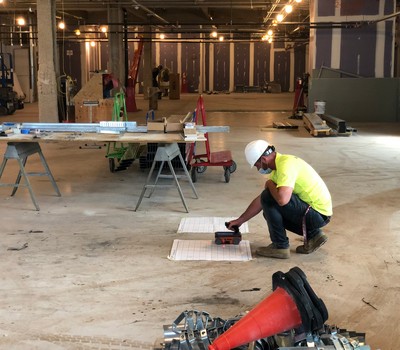Unveil the Transformative Power of Concrete Scanning in Maximizing Performance and Safety And Security
Concrete scanning has arised as an essential tool in the building market, offering unequaled benefits in boosting project effectiveness and making certain safety requirements. The transformative power of concrete scanning exists in its capability to provide in-depth understandings and real-time information, changing just how projects are intended and carried out.
Relevance of Concrete Scanning
Ensuring the structural integrity and safety and security of building and construction tasks starts with the crucial step of carrying out extensive concrete scanning. Concrete scanning is a non-destructive method made use of to spot and map subsurface elements within concrete structures.
In addition, concrete scanning aids in maximizing project timelines and spending plan by staying clear of unforeseen costs and hold-ups that might arise due to unexpected obstructions within the concrete. Inevitably, investing in comprehensive concrete scanning is an aggressive technique that enhances both efficiency and safety and security in construction tasks.
Exactly How Concrete Scanning Works
Concrete scanning runs as a critical tool in construction tasks by utilizing sophisticated technologies to detect and map subsurface aspects without creating architectural damages. Ground Passing Through Radar (GPR) and Electromagnetic Induction (EMI) are 2 main techniques used in concrete scanning. GPR works by producing high-frequency radar pulses into the surface area, which bounce back when they come across subsurface objects or gaps. The time taken for the signal to return shows the deepness and place of the things. EMI, on the other hand, uses magnetic fields to recognize variances in product structures, such as recognizing rebar or conduits within concrete structures.
Throughout the scanning process, the data gathered is assessed in real-time, enabling prompt identification of potential risks or barriers below the surface area. By employing these innovative innovations, concrete scanning dramatically reduces the risk of pricey problems and injuries on construction sites.
Advantages of Concrete Scanning
Utilizing innovative scanning innovations in building projects uses a multitude of benefits, boosting both efficiency and security on-site. Among the main advantages of concrete scanning is the ability to detect and situate embedded objects such as rebar, post-tension wires, and avenues accurately. By identifying these components prior to drilling or reducing right into concrete structures, the danger of accidental strikes is significantly decreased, protecting against possible injuries to employees and damage to the structure itself. Additionally, concrete scanning assists in preparation and creating more properly, as it supplies exact information about the area and depth of architectural components.

Study: Concrete Scanning Success

In another case, a building firm made use of 3D concrete scanning to evaluate the condition old concrete frameworks in a historic structure. The in-depth scans provided beneficial understandings right into the extent of degeneration and helped focus on maintenance efforts successfully. By proactively resolving areas of problem identified through scanning, the company had the ability to prolong the life-span of the structure and ensure passenger safety.
These study highlight the transformative power of concrete scanning in enhancing effectiveness, precision, and safety in building tasks.
Carrying Out Concrete Scanning in Projects
Implementing advanced scanning innovations during building jobs has come to be increasingly important for boosting accuracy and security. By incorporating concrete scanning into project preparation and implementation, building groups can recognize possible risks, such as rebar or post-tension cables, concealed within concrete structures. This positive approach minimizes the risk of mishaps, delays, and pricey rework, ultimately causing a lot more reliable job timelines and budgets.
To apply concrete scanning properly, task supervisors must work together carefully with knowledgeable scanning experts to determine the most suitable scanning techniques for the particular project requirements. Involving scanning professionals from the early stages of a task makes it possible for the group to create thorough scanning plans that resolve key areas of worry and ensure extensive information collection.
Moreover, incorporating concrete scanning right into normal project workflows can enhance decision-making processes, as real-time check data gives prompt insights into the problem of concrete structures - Concrete Scanning. This data-driven method promotes educated analytical and makes it possible for groups to make modifications without delay, fostering a society of effectiveness and safety and security throughout the job lifecycle

Conclusion
Finally, concrete scanning plays an important duty in enhancing efficiency and safety in building projects. By making use of sophisticated technology to spot and map out underlying frameworks within concrete, this process aids to avoid costly errors, ensure structural integrity, and minimize my latest blog post risks on site. With the ability to uncover concealed elements and offer precise data, concrete scanning verifies to be a beneficial tool for enhancing job outcomes and making best use of general success.
Concrete scanning is a non-destructive approach made use of to identify and map subsurface components within concrete structures. Furthermore, concrete scanning aids in maximizing project timelines and budget by staying clear of unforeseen costs and hold-ups that might develop due to unforeseen obstructions within the concrete. One noteworthy situation research study involves a massive restoration task where concrete scanning played a vital duty in guaranteeing project success.In one more instance, a construction firm made use of 3D concrete scanning to analyze the condition of maturing concrete structures in a historical structure. By incorporating concrete scanning into project preparation and execution, construction teams can identify prospective threats, such as rebar or post-tension cables, concealed within concrete structures.